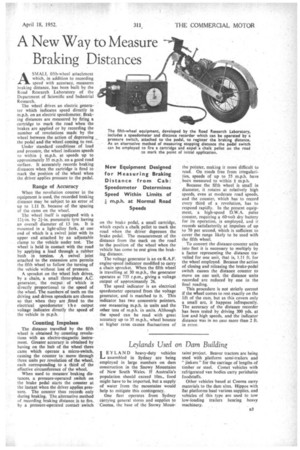A New Way to Measure Braking Distances
Page 37

If you've noticed an error in this article please click here to report it so we can fix it.
ASMALL fifth-wheel attachment which, in addition to recording speed with accuracy, measures braking distance, has been built by the Road Research Laboratory of the Department of Scientific and Industrial Research.
The wheel drives an electric generator which indicates speed directly in m.p.h. on an electric speedometer. Braking distances are measured by firing a cartridge to mark the road when the brakes are applied or by recording the number of revolutions made by the wheel between the action of depressing the pedal and the wheel coming to rest.
Under standard conditions of load and pressure, the wheel indicates speeds to within i m.p.h. at speeds up to approximately 35 m.p.h. on a good road surface. It accurately records braking distances when the cartridge is fired to mark the position of the wheel when the driver applies pressure to the pedal.
Range of Accuracy
When the revolution counter in the equipment is used, the recorded braking distance may be subject to an error of up to 1.11 ft. because of the spacing of the cams on the wheel.
The wheel itself is equipped with a 124.-in. by 21-in. pneumatic tyre having an overall diameter of 13 ins. It is mounted in a light-alloy fork, at one end of which is a swivel joint with its upper end attached by an adjustable clamp to the vehicle under test. The wheel is held in contact with the road by applying a load through a rubber bush in torsion. A swivel joint attached to the extension arm permits the fifth wheel to follow the turning of the vehicle without loss of pressure.
A sprocket on the wheel hub drives, by a chain, a small three-phase A.C. generator, the output of which is directly proportional to the speed of the wheeL The numbers of teeth on the driving and driven sprockets are chosen so that when they are .fitted to the electrical speedometer t h e output voltage indicates directly the speed of the vehicle in m.p.h.
Counting Impulses The distance travelled by the fifth wheel is obtained by . counting revolutions with an electro-magnetic instrument. Greater accuracy is obtained by having on the hub of the wheel three cams which operate a micro-switch, causing the counter to move through three units per revolution of the wheel, each corresponding to a third of the effective circumference of the wheel.
When used to measure braking distances, a pressure-operated swhch on the brake pedal starts the counter at the instant when the driver applies pressure. The counter thus records only during braking. The alternative method of recording braking distance is to fire, by a pressure-operated contact switch on the brake pedal, a small cartridge, which expels a chalk pellet to mark the road when the driver depresses the brake pedal. The measurement of the distance from the mark on the road to the position of the wheel when the vehicle has come to rest gives the braking distance.
The voltage generator is an ex-R.A.F. engine-speed indicator modified to carry a chain sprocket. When the fifth wheel is travelling at 30 m.p.h., the generator operates at 735 r.p.m., giving a voltageoutput of approximately 26.
The speed indicator is an electrical speedometer operated from the voltage generator, and is matched to it. This indicator has two concentric pointers, one measuring m.p.h. in units and the ogler tens of m.p.h. in units. Although the speed can be read with great accuracy up to 35 m.p.h., wheel bounce at higher rates causes fluctuations of
the pointer, making it more difficult to read. On roads free from irregularities, speeds of up to 55 m.p.h. have been measured to within i• m.p.h.
Because the fifth wheel is small in diameter, it rotates at relatively high speeds, even 'at moderate road speeds, and the counter, which has to record every third of a revolution, has' to respond rapidly. In the present equipment, a high-speed D.W.A. pulse counter, requiring a 60-volt dry battery for its operation, is employed, and it records satisfactorily at impulses of up to 70 per second which is sufficient to cover the range likely to be used with the fifth wheel.
To convert the distance-counter units into. feet it is necessary to multiply by a factor representing the distance travelled for one unit, that is, 1.11 ft. for the wheel employed. Because the action of closing and releasing the brake-pedal switch causes the distance counter to move on one unit, the distance units recorded • are reduced by one in the final reading.
This procedure is not strictly correct if the wheel comes to rest exactly on the lift of the cam, but as this covers only a small arc, it happens infrequently. The accuracy of the distance recorder has been tested by driving 300 yds. at low and high speeds, and the indicator distance was in no case more than 2 ft. in error.












































































